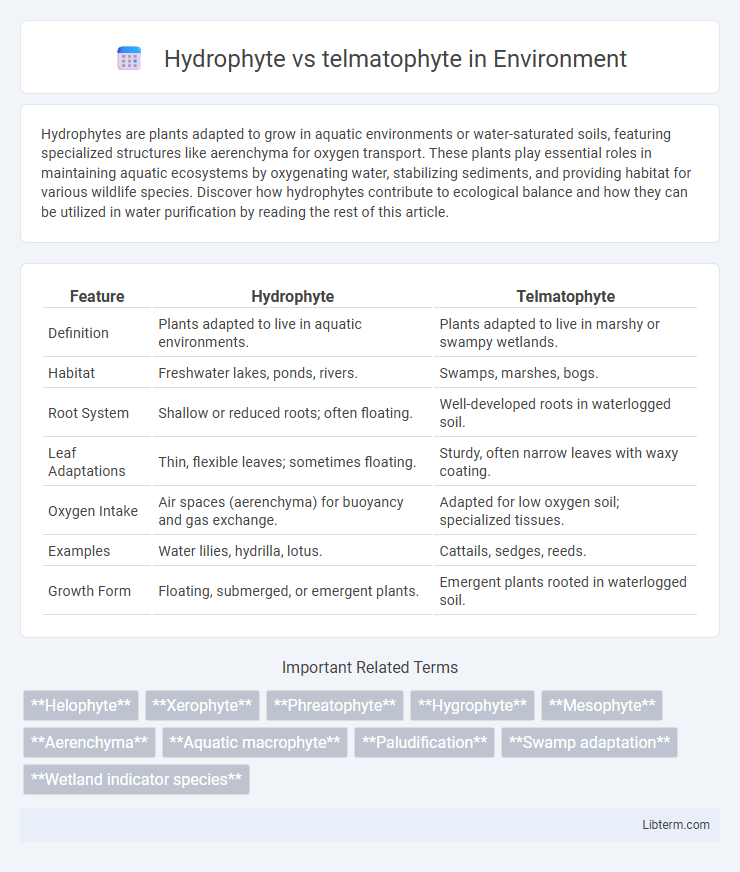Hydrophytes are plants adapted to grow in aquatic environments or water-saturated soils, featuring specialized structures like aerenchyma for oxygen transport. These plants play essential roles in maintaining aquatic ecosystems by oxygenating water, stabilizing sediments, and providing habitat for various wildlife species. Discover how hydrophytes contribute to ecological balance and how they can be utilized in water purification by reading the rest of this article.
Table of Comparison
| Feature | Hydrophyte | Telmatophyte |
|---|---|---|
| Definition | Plants adapted to live in aquatic environments. | Plants adapted to live in marshy or swampy wetlands. |
| Habitat | Freshwater lakes, ponds, rivers. | Swamps, marshes, bogs. |
| Root System | Shallow or reduced roots; often floating. | Well-developed roots in waterlogged soil. |
| Leaf Adaptations | Thin, flexible leaves; sometimes floating. | Sturdy, often narrow leaves with waxy coating. |
| Oxygen Intake | Air spaces (aerenchyma) for buoyancy and gas exchange. | Adapted for low oxygen soil; specialized tissues. |
| Examples | Water lilies, hydrilla, lotus. | Cattails, sedges, reeds. |
| Growth Form | Floating, submerged, or emergent plants. | Emergent plants rooted in waterlogged soil. |
Introduction to Hydrophytes and Telmatophytes
Hydrophytes are specialized plants adapted to grow in aquatic environments with abundant water, such as ponds, lakes, and marshes, exhibiting features like thin cuticles and air-filled tissues for buoyancy. Telmatophytes, commonly known as marsh plants, thrive in wetland areas with waterlogged soils, showing adaptations for low oxygen conditions in the root zone and often possessing extensive rhizome systems. Both groups play crucial roles in aquatic and semi-aquatic ecosystems, contributing to habitat stability and water purification.
Defining Hydrophytes: Key Characteristics
Hydrophytes are plants adapted to grow in aquatic environments with submerged or floating leaves, specialized air-filled tissues for buoyancy, and roots that efficiently absorb oxygen in waterlogged conditions. These plants exhibit traits such as reduced cuticles, stomata on upper leaf surfaces, and aerenchyma to facilitate gas exchange underwater. Unlike telmatophytes, which primarily thrive in marshy or swampy terrestrial habitats with periodic water presence, hydrophytes are fully aquatic and rely on specific structural and physiological adaptations for survival.
Understanding Telmatophytes: Essential Traits
Telmatophytes are specialized wetland plants adapted to waterlogged soils and anaerobic conditions, featuring extensive aerenchyma tissue that facilitates oxygen transport to submerged roots. Unlike hydrophytes, which thrive fully submerged or floating in aquatic environments, telmatophytes typically grow in marshy or swampy areas with fluctuating water levels. Key traits include robust root systems for anchorage, adaptability to nutrient-poor substrates, and physiological mechanisms to tolerate periodic drought and flooding.
Habitat Differences: Aquatic vs. Marsh Environments
Hydrophytes thrive in fully aquatic environments such as ponds, lakes, and rivers, where they are submerged or floating on water surfaces. Telmatophytes inhabit marshy or swampy regions with saturated soils, often at the interface of land and water, characterized by periodic flooding and shallow water levels. These habitat differences influence root structure, aeration mechanisms, and overall plant adaptations to oxygen availability and water saturation.
Morphological Adaptations in Hydrophytes
Hydrophytes exhibit specialized morphological adaptations such as aerenchyma tissues that facilitate buoyancy and efficient gas exchange in aquatic environments. Their leaves are often thin, flexible, and lacking a thick cuticle to maximize light absorption and reduce resistance underwater. Root systems in hydrophytes are generally reduced or modified to anchor the plant while allowing nutrient absorption from water.
Adaptive Features of Telmatophytes
Telmatophytes exhibit specialized adaptive features such as aerenchyma tissue for efficient oxygen transport in waterlogged soils, extensive root systems for anchorage and nutrient absorption in marshy environments, and wax-coated leaves to reduce water loss and prevent rot. Unlike hydrophytes, which thrive fully submerged, telmatophytes are adapted to fluctuating water conditions, enabling survival in swampy and semi-aquatic habitats. Their morphological and physiological traits optimize gas exchange and structural stability in saturated, anaerobic substrates.
Ecological Roles in Their Respective Ecosystems
Hydrophytes, adapted to aquatic environments, play a crucial role in stabilizing sediment and improving water quality by absorbing excess nutrients and providing habitat for aquatic fauna. Telmatophytes, or marsh plants, contribute significantly to wetland ecosystems by facilitating water filtration, offering shelter for a diverse range of wildlife, and helping to maintain hydrological balance. Both plant types support biodiversity and contribute to ecosystem services essential for maintaining aquatic and semi-aquatic habitats.
Examples of Common Hydrophyte Species
Hydrophytes include species such as water lilies (Nymphaea), hydrilla (Hydrilla verticillata), and duckweed (Lemna minor), all adapted to aquatic environments with specialized structures for submerged life. Telmatophytes, by contrast, thrive in swampy or marshy areas, exemplified by cattails (Typha latifolia) and bulrushes (Schoenoplectus spp.), which possess adaptations for waterlogged soils but often have aerial parts. These distinctions highlight the ecological and morphological diversity between fully aquatic hydrophytes and partially aquatic telmatophytes.
Notable Telmatophyte Plants and Their Importance
Notable telmatophyte plants such as cattails (Typha spp.), reeds (Phragmites australis), and bulrushes (Scirpus spp.) play vital roles in wetland ecosystems by providing habitat, stabilizing soil, and improving water quality through nutrient filtration. These plants contribute to biodiversity by supporting aquatic and terrestrial species, while their dense root systems reduce erosion and enhance sediment accumulation. Telmatophytes are crucial in maintaining wetland health, aiding in flood control, and offering resources for traditional uses and habitat restoration projects.
Comparative Analysis: Hydrophytes vs. Telmatophytes
Hydrophytes are aquatic plants adapted to grow in water-saturated environments with features such as aerenchyma for buoyancy and reduced cuticles to facilitate gas exchange, while telmatophytes thrive in marshy, waterlogged soils and exhibit adaptations like extensive root systems for anchorage and nutrient absorption. Both plant types optimize survival in wet habitats but differ primarily in their habitat specificity and morphological traits, with hydrophytes being fully submerged or floating and telmatophytes rooted in soggy ground. These distinctions impact their ecological roles, with hydrophytes contributing to oxygenation of water bodies and telmatophytes stabilizing wetland substrates and supporting diverse wildlife.
Hydrophyte Infographic

 libterm.com
libterm.com